Abstract
The nerve agents, GA, GB, and VX are organophosphorus esters that form a major portion of the total agent volume contained in the U.S. stockpile of unitary chemical munitions. Congress has mandated the destruction of these agents, which is currently slated for completion in 2004. The acute, chronic, and delayed toxicity of these agents is reviewed in this analysis. The largely negative results from studies of genotoxicity, carcinogenicity, developmental, and reproductive toxicity are also presented. Nerve agents show few or delayed effects. At supralethal doses, GB can cause delayed neuropathy in antidote-protected chickens, but there is no evidence that it causes this syndrome in humans at any dose. Agent VX shows no potential for inducing delayed neuropathy in any species. In view of their lack of genotoxcity, the nerve agents are not likely to be carcinogens. The overreaching concern with regard to nerve agent exposure is the extraordinarily high acute toxicity of these substances. Furthermore, acute effects of moderate exposure such as nausea, diarrhea, inability to perform simple mental tasks, and respiratory effects may render the public unable to respond adequately to emergency instructions in the unlikely event of agent releaase, making early warning and exposure avoidance important. Likewise, exposure or self-contamination of first responders and medical personnel must be avoided. Control limits for exposure via surface contact of drinking water are needed, as are detection methods for low levels in water or foodstuffs.
Full text
PDF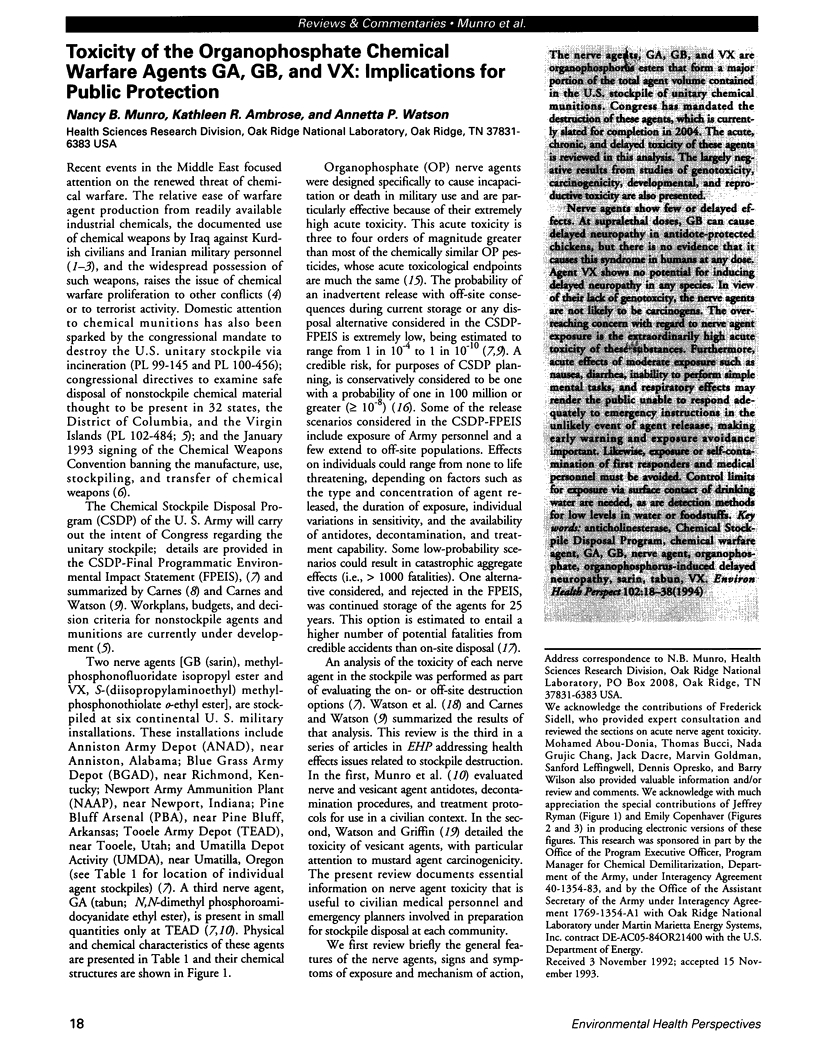
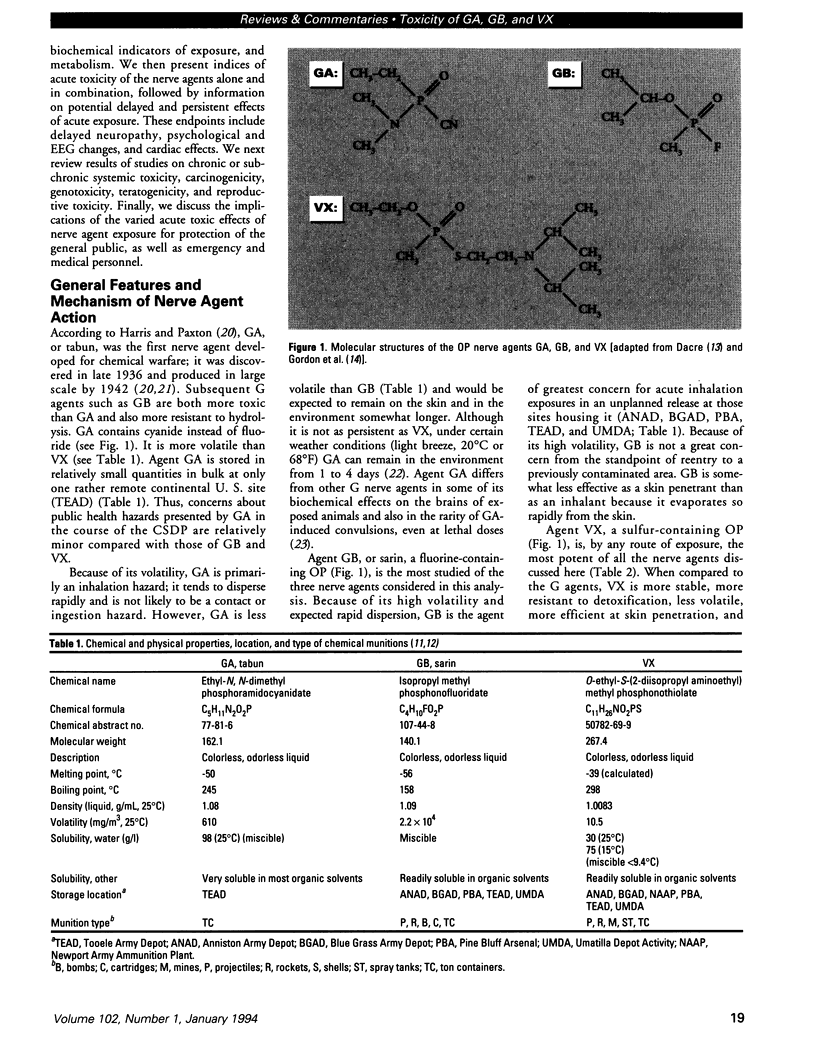
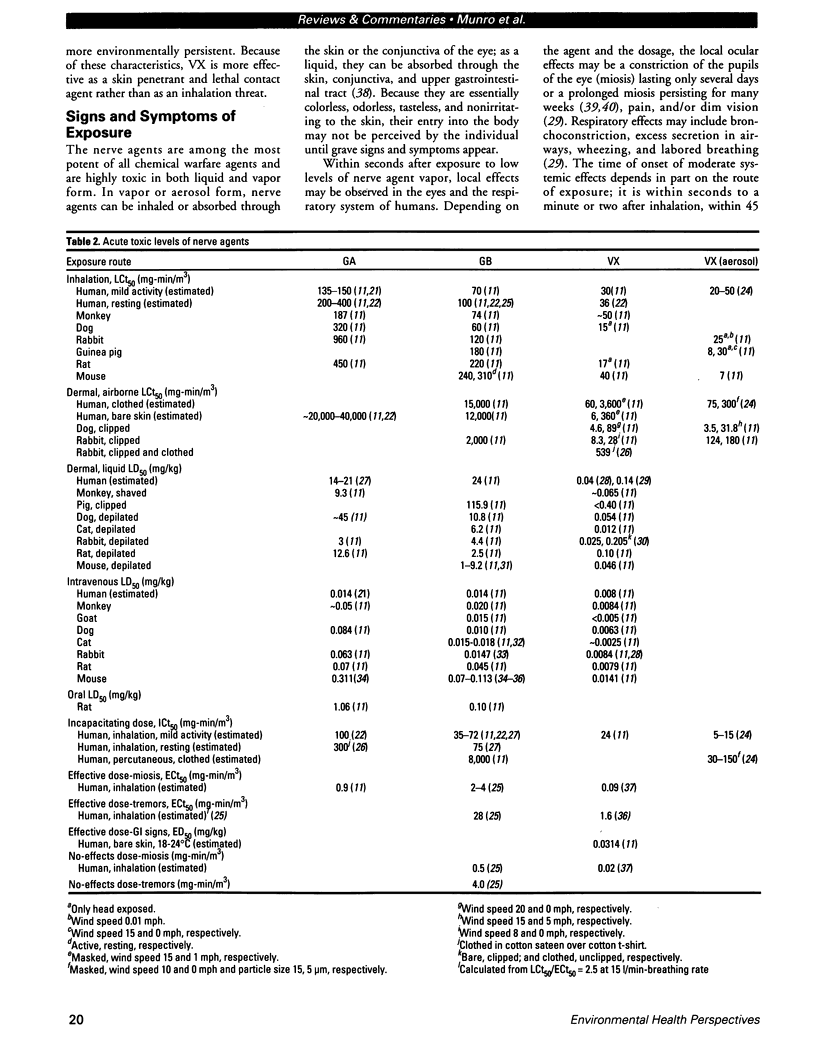
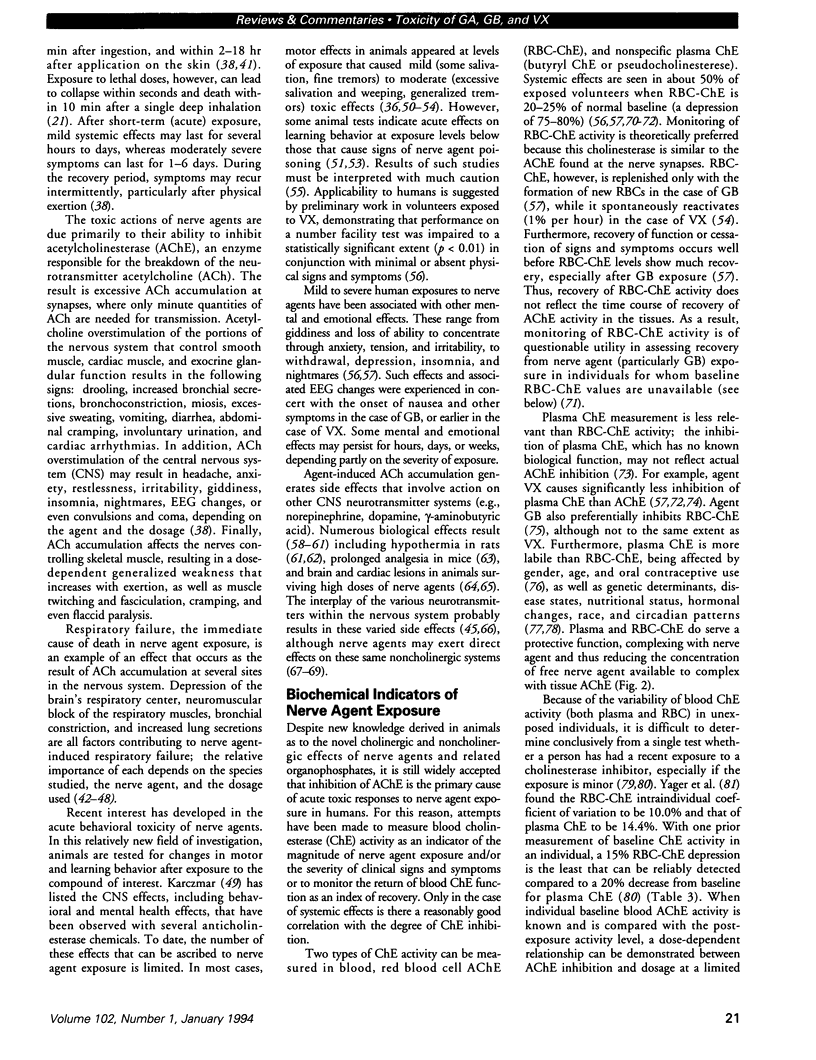
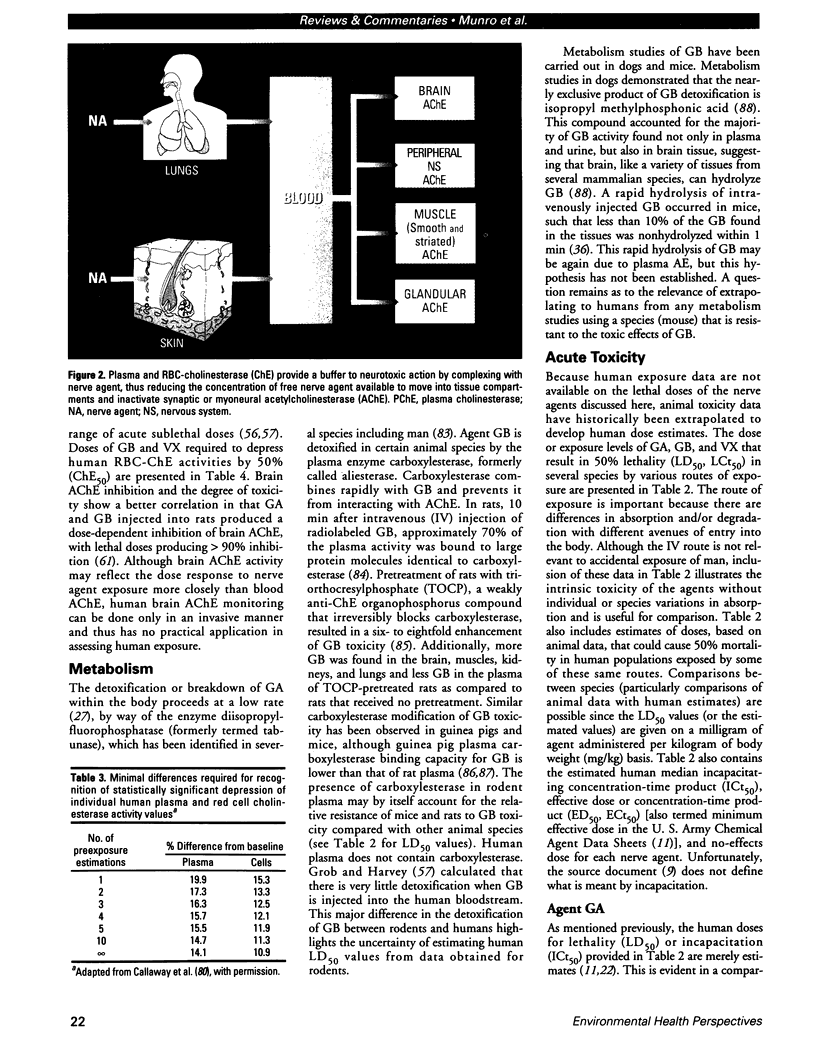
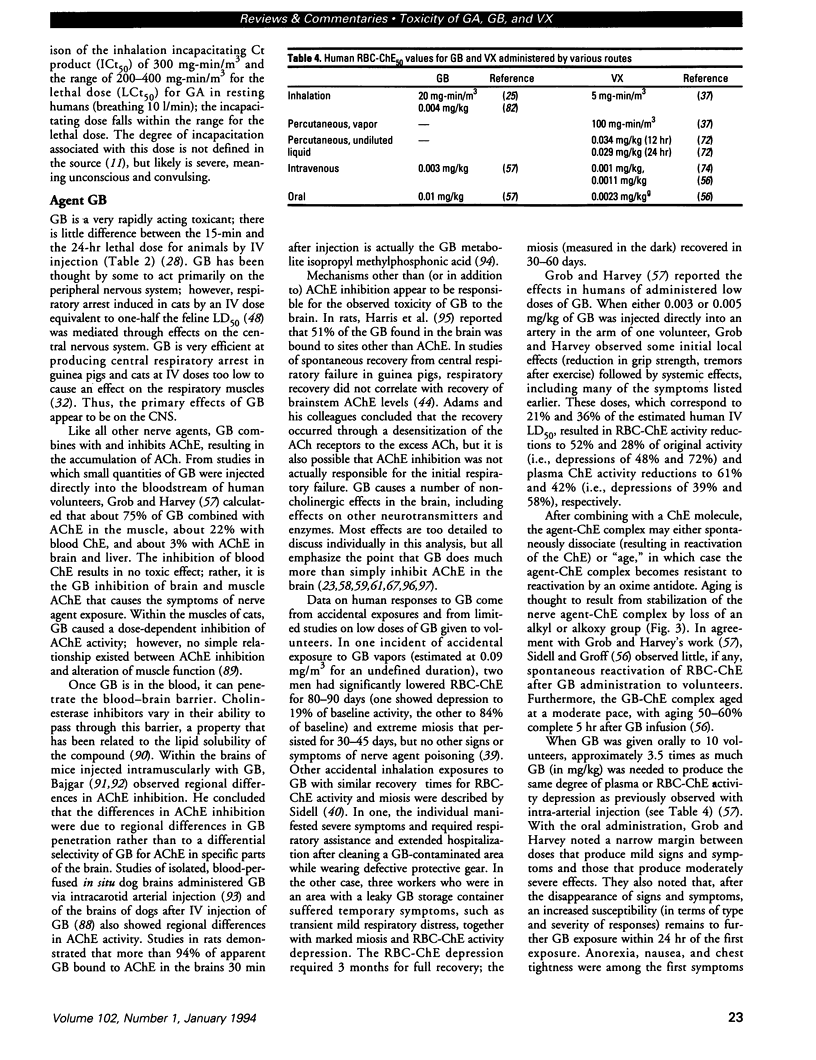
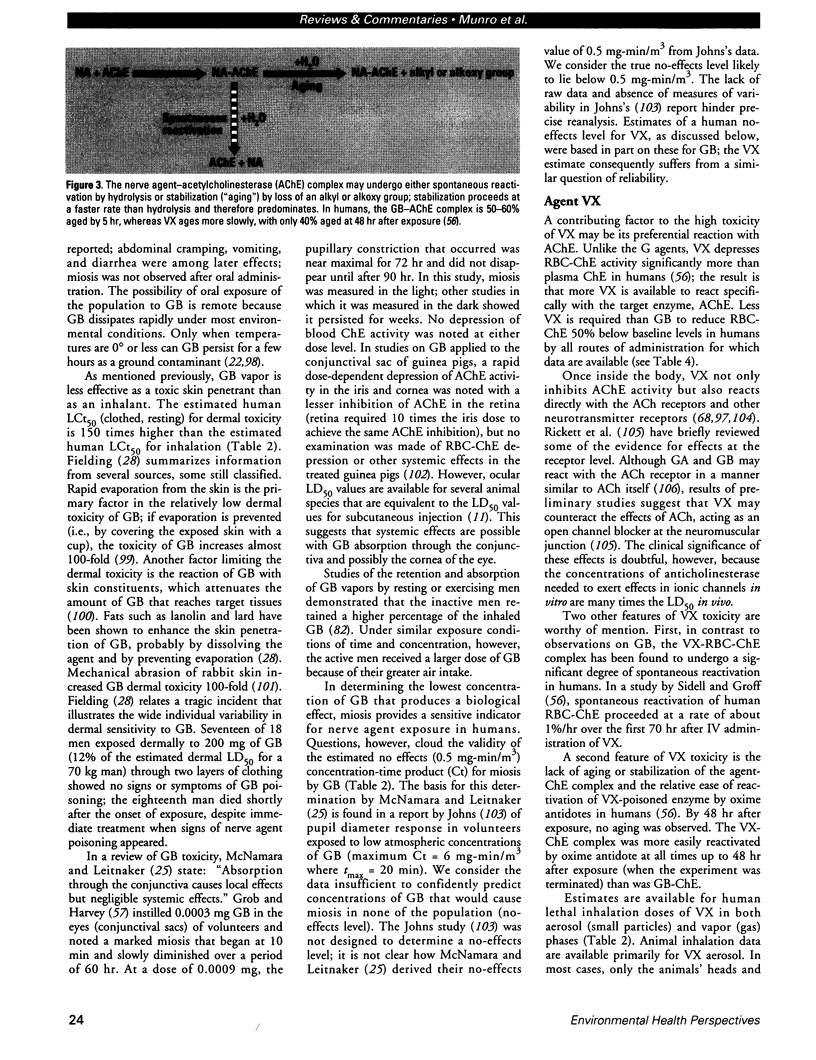
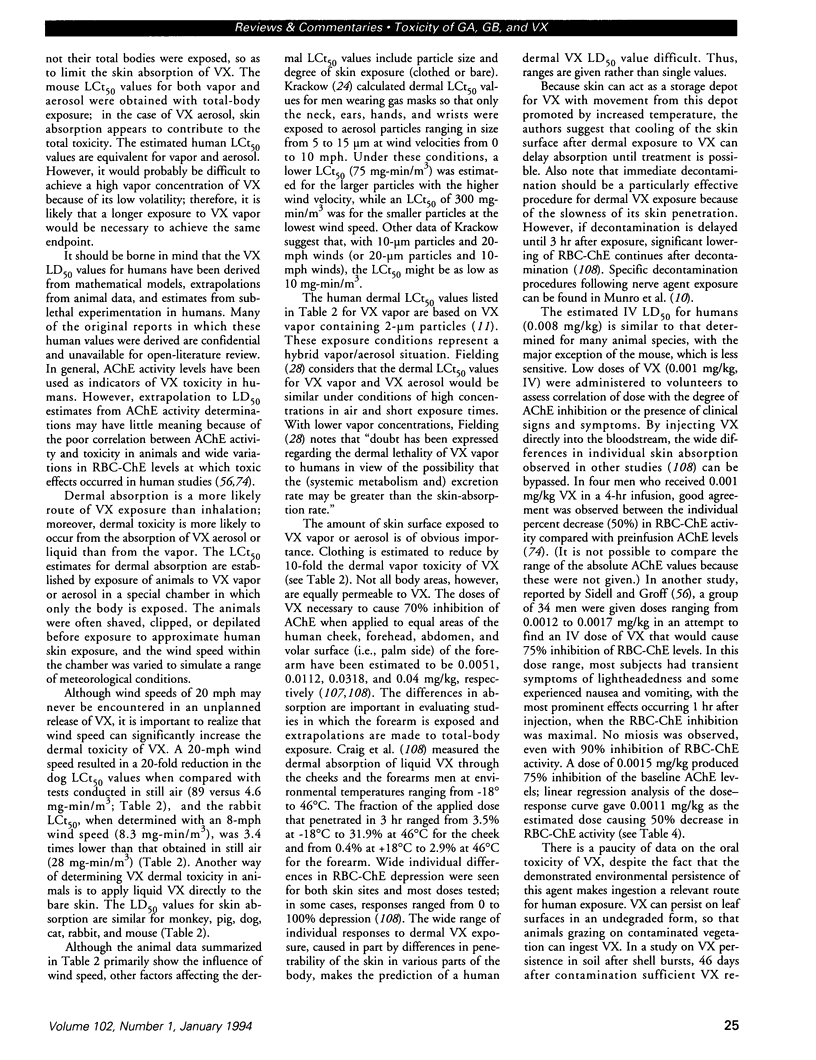
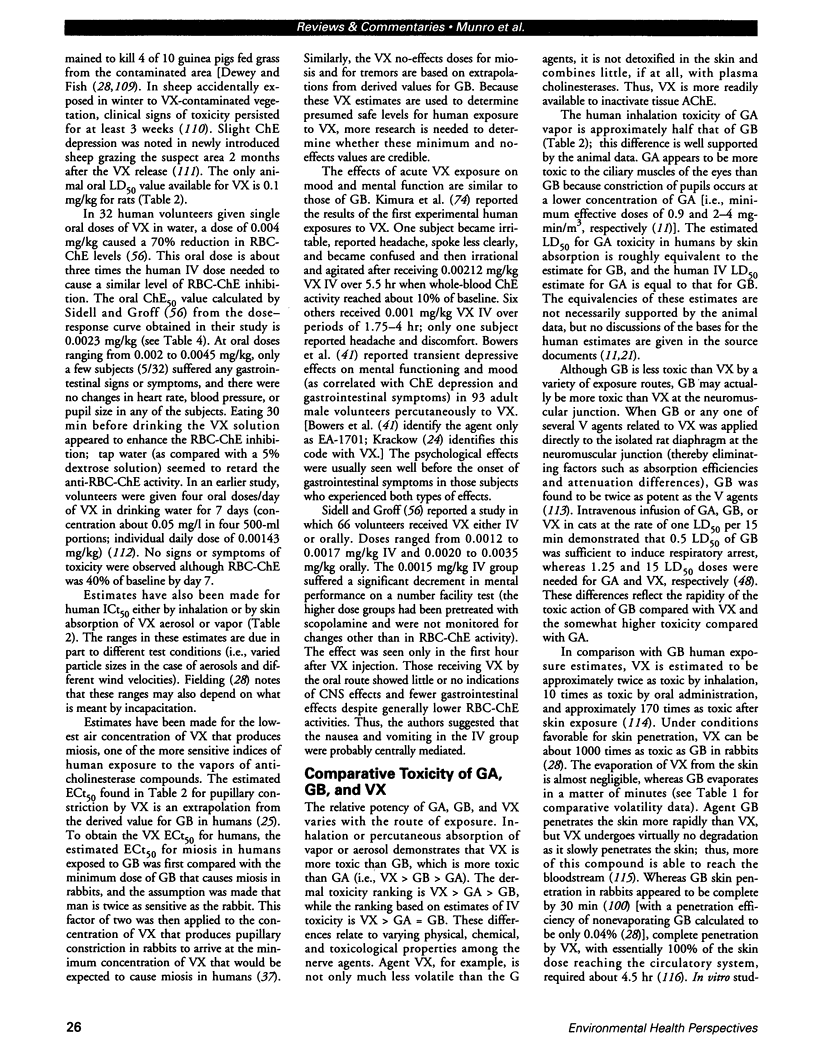
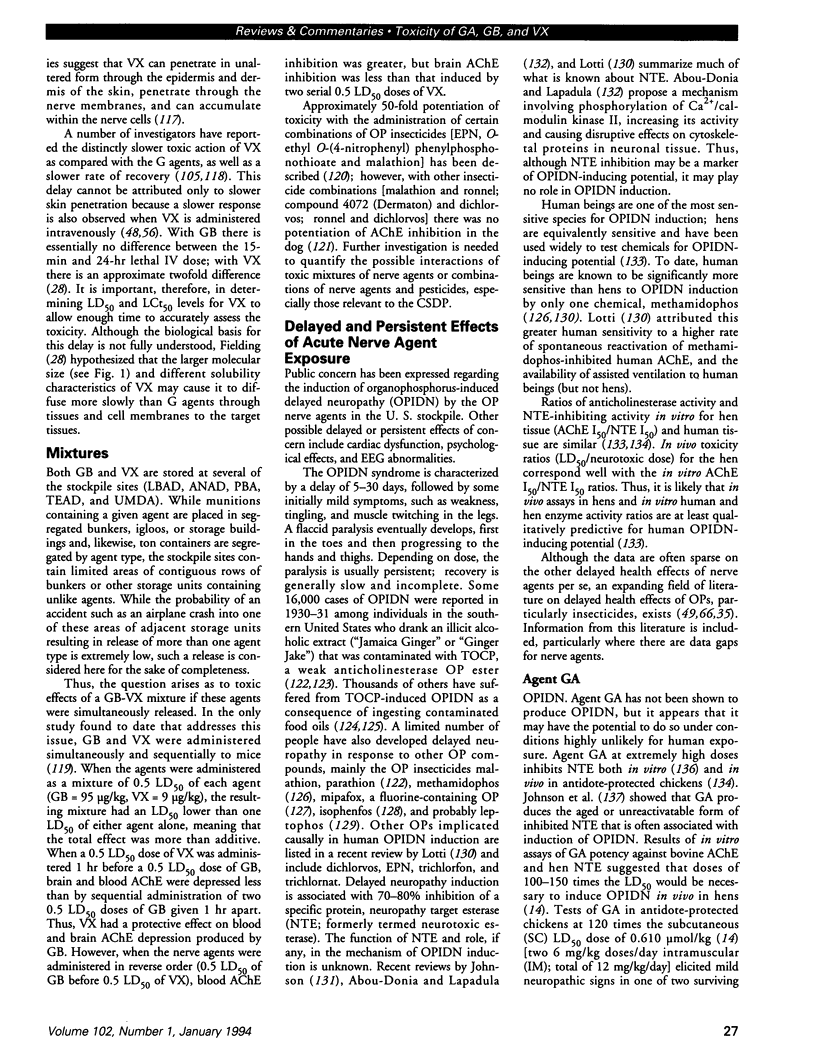
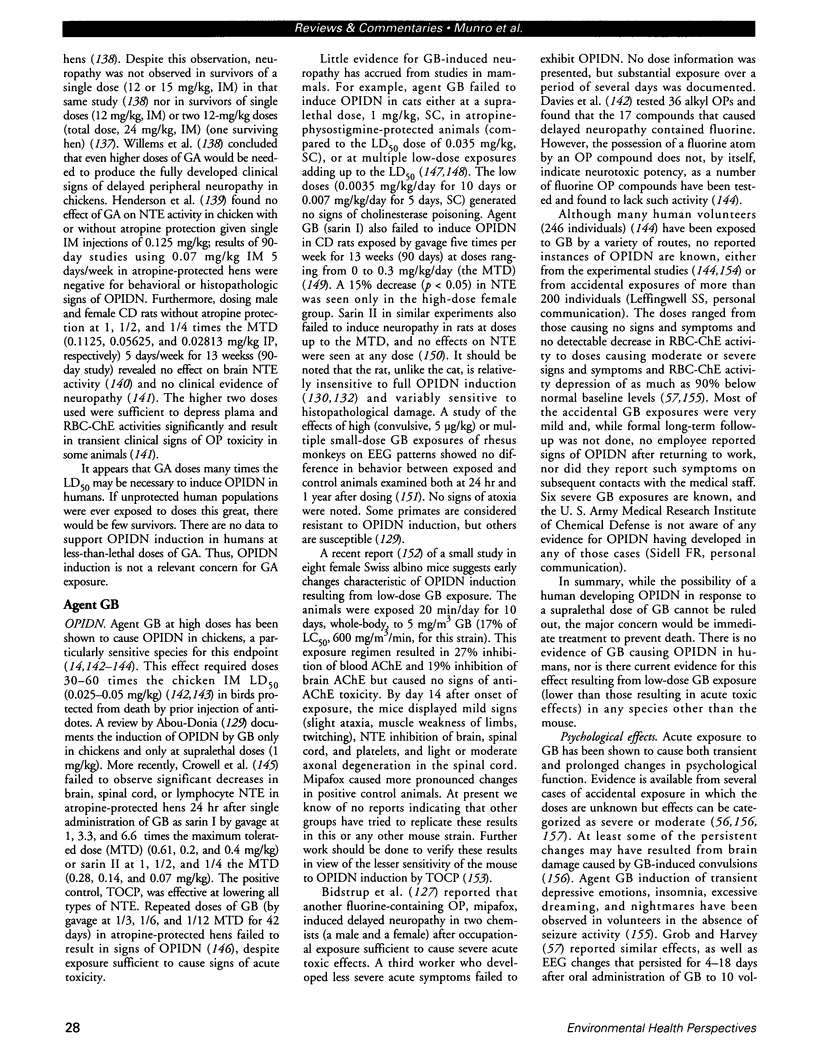
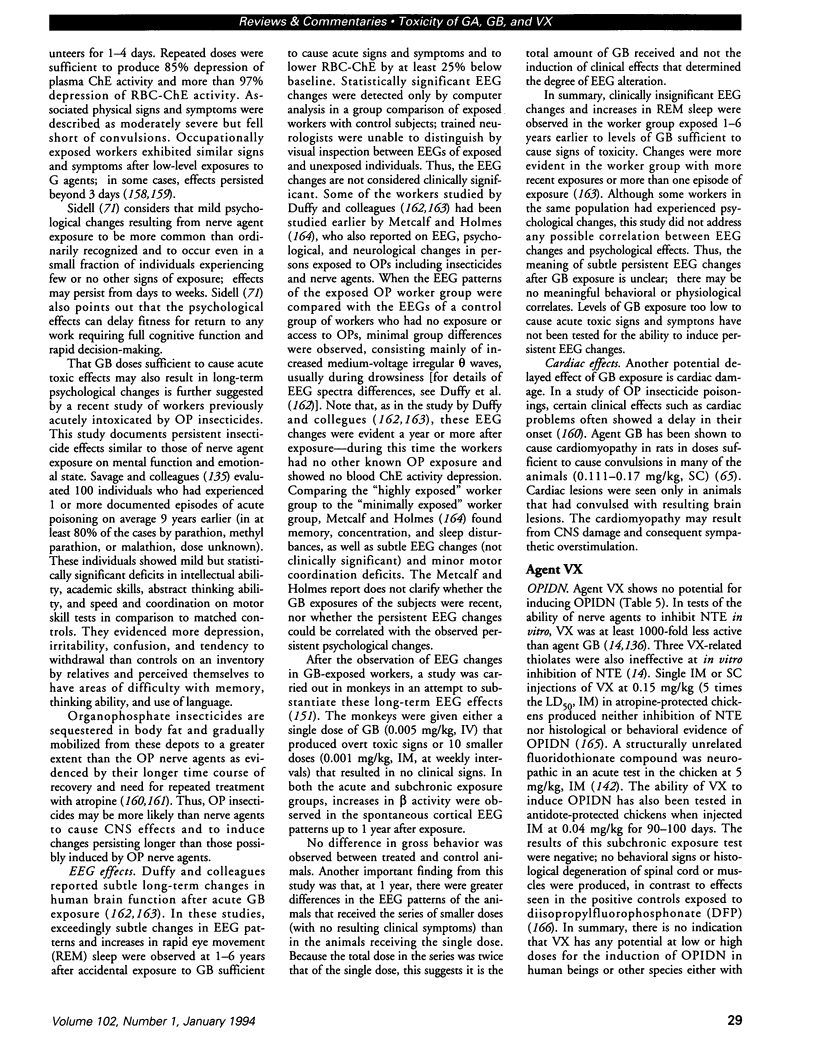
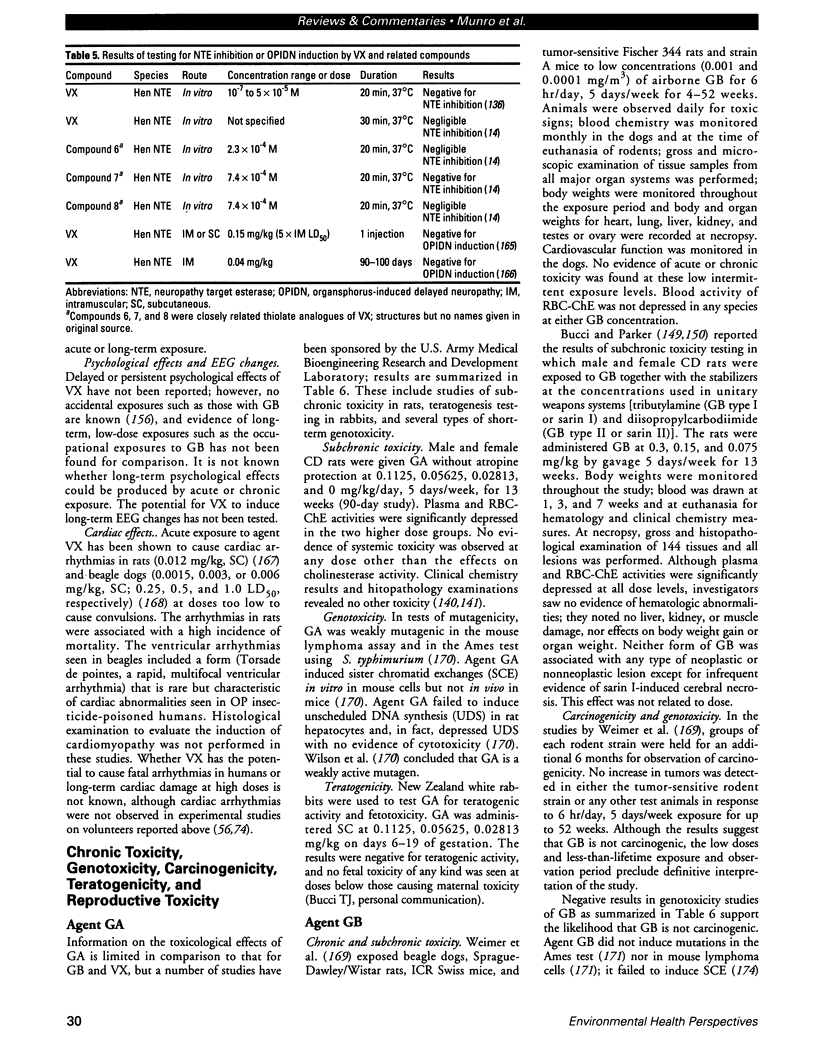
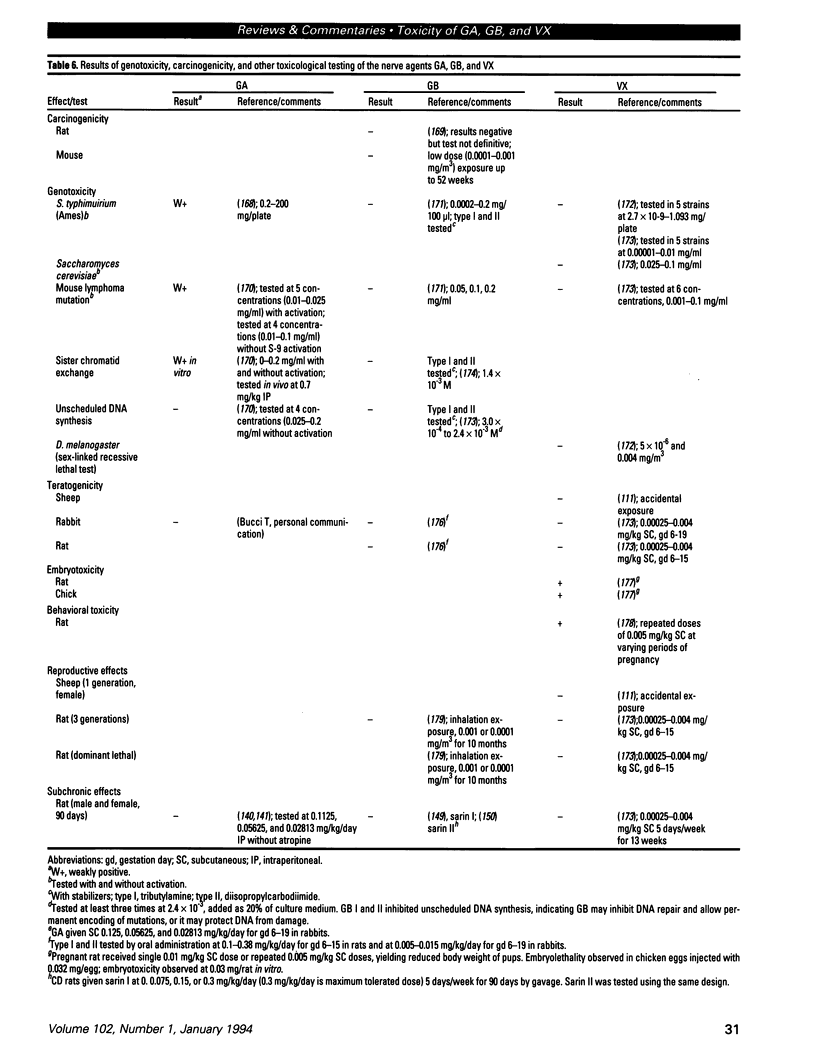

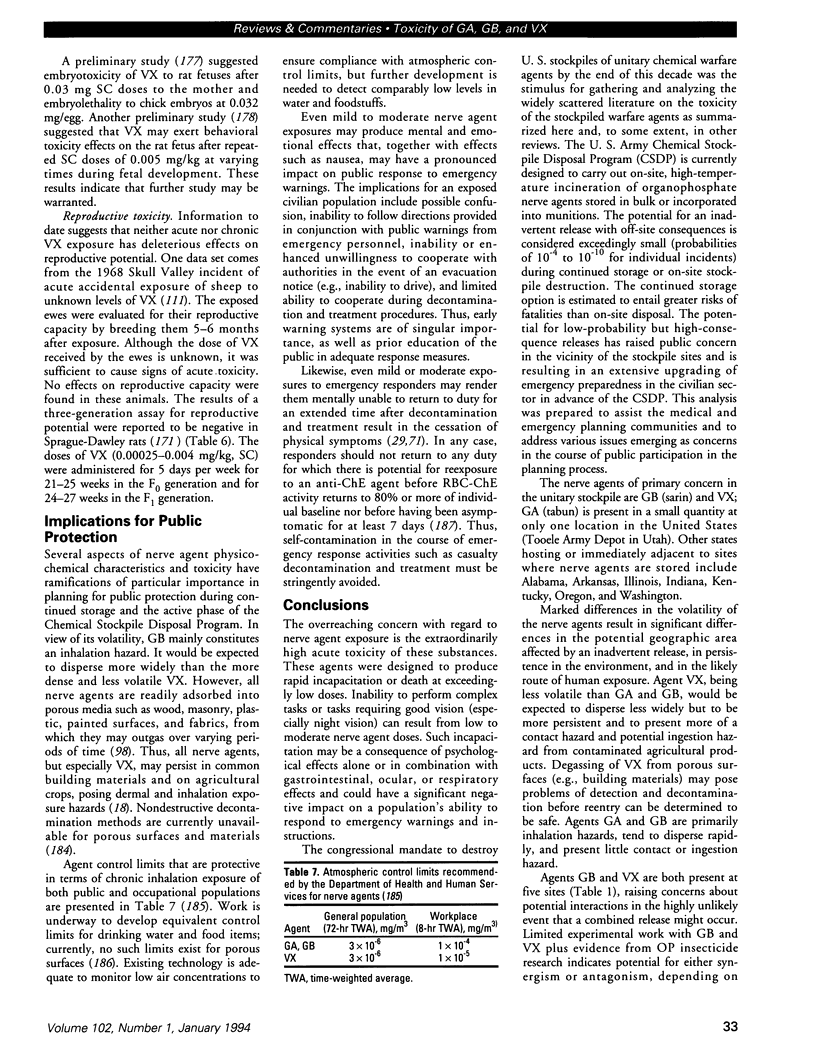
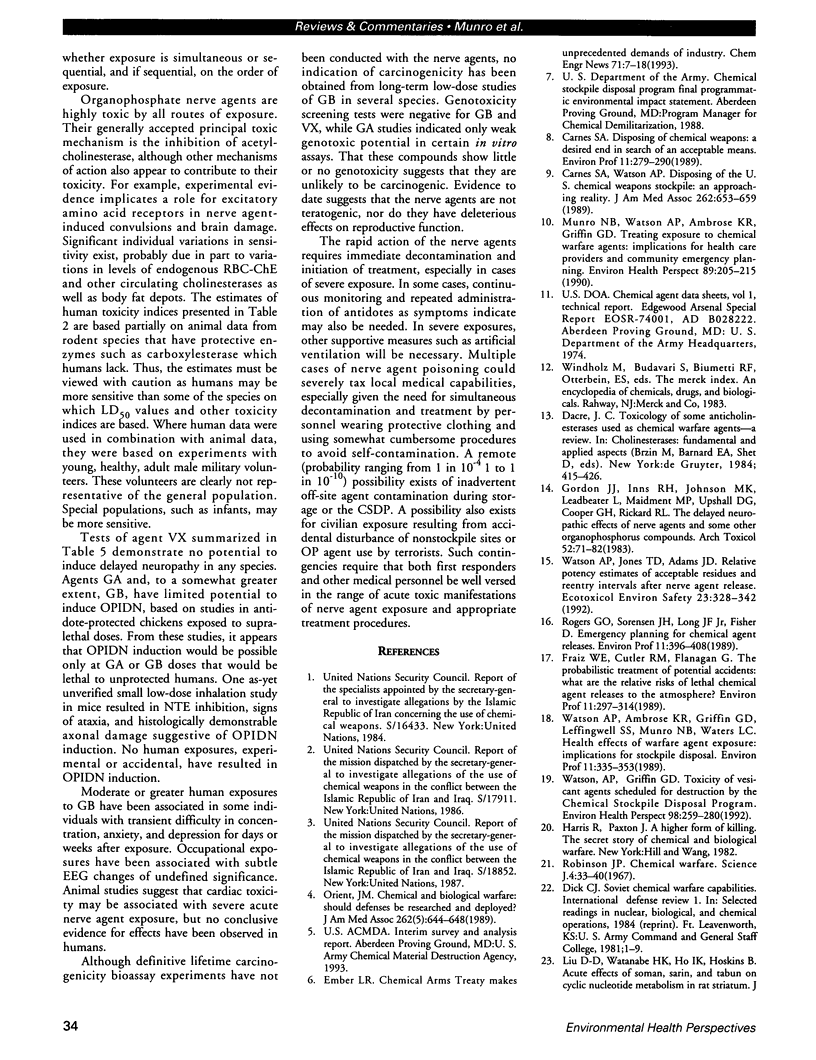
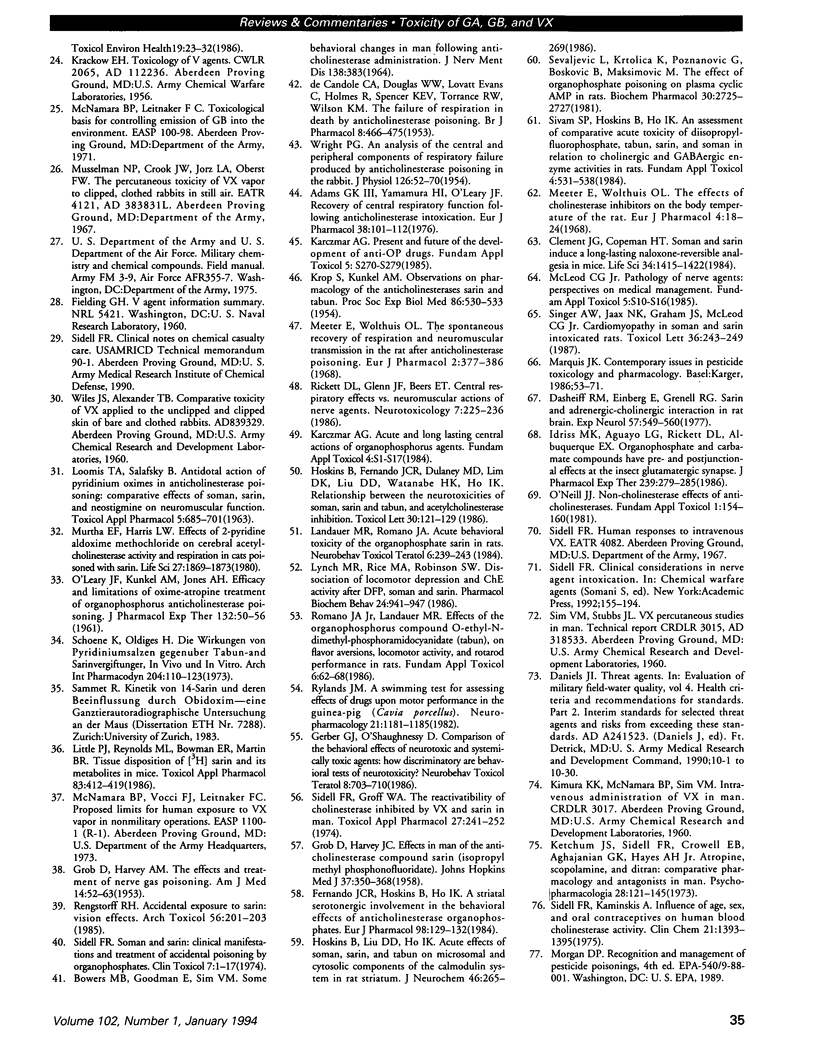
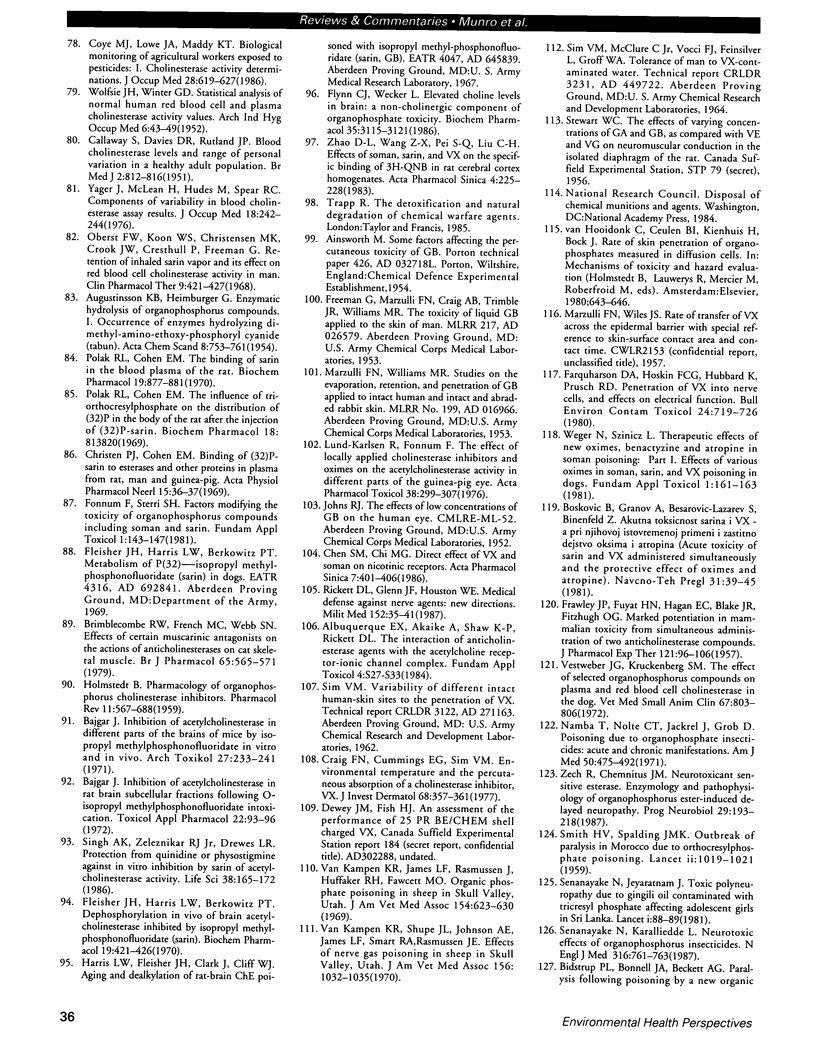
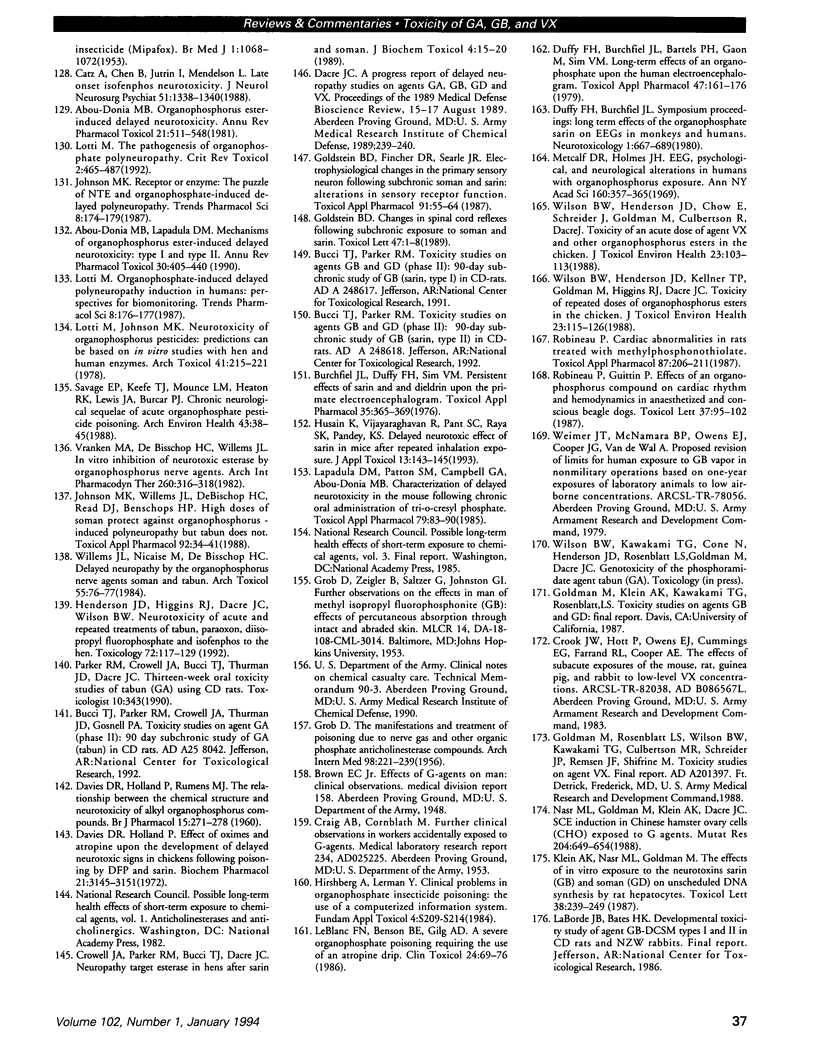

Images in this article
Selected References
These references are in PubMed. This may not be the complete list of references from this article.
- Abou-Donia M. B., Lapadula D. M. Mechanisms of organophosphorus ester-induced delayed neurotoxicity: type I and type II. Annu Rev Pharmacol Toxicol. 1990;30:405–440. doi: 10.1146/annurev.pa.30.040190.002201. [DOI] [PubMed] [Google Scholar]
- Abou-Donia M. B. Organophosphorus ester-induced delayed neurotoxicity. Annu Rev Pharmacol Toxicol. 1981;21:511–548. doi: 10.1146/annurev.pa.21.040181.002455. [DOI] [PubMed] [Google Scholar]
- Adams G. K., 3rd, Yamamura H. I., O'Leary J. F. Recovery of central respiratory function following anticholinesterase intoxication. Eur J Pharmacol. 1976 Jul;38(1):101–112. doi: 10.1016/0014-2999(76)90206-5. [DOI] [PubMed] [Google Scholar]
- Albuquerque E. X., Akaike A., Shaw K. P., Rickett D. L. The interaction of anticholinesterase agents with the acetylcholine receptor-ionic channel complex. Fundam Appl Toxicol. 1984 Apr;4(2 Pt 2):S27–S33. doi: 10.1016/0272-0590(84)90135-0. [DOI] [PubMed] [Google Scholar]
- Amacher D. E., Paillet S., Ray V. A. Point mutations at the thymidine kinase locus in L5178Y mouse lymphoma cells. I. Application to genetic toxicological testing. Mutat Res. 1979 Dec;64(6):391–406. doi: 10.1016/0165-1161(79)90109-2. [DOI] [PubMed] [Google Scholar]
- BOWERS M. B., Jr, GOODMAN E., SIM V. M. SOME BEHAVIORAL CHANGES IN MAN FOLLOWING ANTICHOLINESTERASE ADMINISTRATION. J Nerv Ment Dis. 1964 Apr;138:383–389. doi: 10.1097/00005053-196404000-00009. [DOI] [PubMed] [Google Scholar]
- Bajgar J. Inhibition of acetylcholinesterase in different parts of the brain of mice by isopropyl methylphosphonofluoridate in vitro and in vivo. Arch Toxikol. 1971;27(3):233–241. doi: 10.1007/BF00315046. [DOI] [PubMed] [Google Scholar]
- Bajgar J. Inhibition of acetylcholinesterase in rat brain subcellular fractions following O-isopropyl methylphosphonofluoridate intoxication. Toxicol Appl Pharmacol. 1972 May;22(1):93–96. doi: 10.1016/0041-008x(72)90228-1. [DOI] [PubMed] [Google Scholar]
- Brimblecombe R. W., French M. C., Webb S. N. Effects of certain muscarinic antagonists on the actions of anticholinesterases on cat skeletal muscle. Br J Pharmacol. 1979 Apr;65(4):565–571. doi: 10.1111/j.1476-5381.1979.tb07865.x. [DOI] [PMC free article] [PubMed] [Google Scholar]
- Burchfiel J. L., Duffy F. H., Van Sim M. Persistent effects of sarin and dieldrin upon the primate electroencephalogram. Toxicol Appl Pharmacol. 1976 Feb;35(2):365–379. doi: 10.1016/0041-008x(76)90296-9. [DOI] [PubMed] [Google Scholar]
- CALLAWAY S., DAVIES D. R., RUTLAND J. P. Blood cholinesterase levels and range of personal variation in a healthy adult population. Br Med J. 1951 Oct 6;2(4735):812–816. doi: 10.1136/bmj.2.4735.812. [DOI] [PMC free article] [PubMed] [Google Scholar]
- Carnes S. A., Watson A. P. Disposing of the US chemical weapons stockpile. An approaching reality. JAMA. 1989 Aug 4;262(5):653–659. [PubMed] [Google Scholar]
- Catz A., Chen B., Jutrin I., Mendelson L. Late onset isofenphos neurotoxicity. J Neurol Neurosurg Psychiatry. 1988 Oct;51(10):1338–1340. doi: 10.1136/jnnp.51.10.1338. [DOI] [PMC free article] [PubMed] [Google Scholar]
- Chen S. M., Chi M. G. [Direct effect of VX and soman on nicotinic receptors]. Zhongguo Yao Li Xue Bao. 1986 Sep;7(5):401–406. [PubMed] [Google Scholar]
- Clement J. G., Copeman H. T. Soman and sarin induce a long-lasting naloxone-reversible analgesia in mice. Life Sci. 1984 Apr 9;34(15):1415–1422. doi: 10.1016/0024-3205(84)90055-9. [DOI] [PubMed] [Google Scholar]
- Clive D., Johnson K. O., Spector J. F., Batson A. G., Brown M. M. Validation and characterization of the L5178Y/TK+/- mouse lymphoma mutagen assay system. Mutat Res. 1979 Jan;59(1):61–108. doi: 10.1016/0027-5107(79)90195-7. [DOI] [PubMed] [Google Scholar]
- Coye M. J., Lowe J. A., Maddy K. T. Biological monitoring of agricultural workers exposed to pesticides: I. Cholinesterase activity determinations. J Occup Med. 1986 Aug;28(8):619–627. doi: 10.1097/00043764-198608000-00018. [DOI] [PubMed] [Google Scholar]
- Craig F. N., Cummings E. G., Sim V. M. Environmental temperature and the percutaneous absorption of a cholinesterase inhibitor, VX. J Invest Dermatol. 1977 Jun;68(6):357–361. doi: 10.1111/1523-1747.ep12496487. [DOI] [PubMed] [Google Scholar]
- Crowell J. A., Parker R. M., Bucci T. J., Dacre J. C. Neuropathy target esterase in hens after sarin and soman. J Biochem Toxicol. 1989 Spring;4(1):15–20. doi: 10.1002/jbt.2570040104. [DOI] [PubMed] [Google Scholar]
- DAVIES D. R., HOLLAND P., RUMENS M. J. The relationship between the chemical structure and neurotoxicity of alkyl organophosphorus compounds. Br J Pharmacol Chemother. 1960 Jun;15:271–278. doi: 10.1111/j.1476-5381.1960.tb01243.x. [DOI] [PMC free article] [PubMed] [Google Scholar]
- DE CANDOLE C. A., DOUGLAS W. W., EVANS C. L., HOLMES R., SPENCER K. E., TORRANCE R. W., WILSON K. M. The failure of respiration in death by anticholinesterase poisoning. Br J Pharmacol Chemother. 1953 Dec;8(4):466–475. doi: 10.1111/j.1476-5381.1953.tb01350.x. [DOI] [PMC free article] [PubMed] [Google Scholar]
- Dasheiff R. M., Einberg E., Grenell R. G. Sarin and adrenergic--cholinergic interaction in rat brain. Exp Neurol. 1977 Nov;57(2):549–560. doi: 10.1016/0014-4886(77)90088-7. [DOI] [PubMed] [Google Scholar]
- Davies D. R., Holland P. Effect of oximes and atropine upon the development of delayed neurotoxic signs in chickens following poisoning by DFP and sarin. Biochem Pharmacol. 1972 Dec 1;21(23):3145–3151. doi: 10.1016/0006-2952(72)90141-4. [DOI] [PubMed] [Google Scholar]
- Duffy F. H., Burchfiel J. L., Bartels P. H., Gaon M., Sim V. M. Long-term effects of an organophosphate upon the human electroencephalogram. Toxicol Appl Pharmacol. 1979 Jan;47(1):161–176. doi: 10.1016/0041-008x(79)90083-8. [DOI] [PubMed] [Google Scholar]
- FRAWLEY J. P., FUYAT H. N., HAGAN E. C., BLAKE J. R., FITZHUGH O. G. Marked potentiation in mammalian toxicity from simultaneous administration of two anticholinesterase compounds. J Pharmacol Exp Ther. 1957 Sep;121(1):96–106. [PubMed] [Google Scholar]
- Farquharson D. A., Hoskin F. C., Hubbard K., Prusch R. D. Penetration of VX into nerve cells, and effects on electrical function. Bull Environ Contam Toxicol. 1980 May;24(5):719–726. doi: 10.1007/BF01608179. [DOI] [PubMed] [Google Scholar]
- Fernando J. C., Hoskins B. H., Ho I. K. A striatal serotonergic involvement in the behavioural effects of anticholinesterase organophosphates. Eur J Pharmacol. 1984 Feb 10;98(1):129–132. doi: 10.1016/0014-2999(84)90118-3. [DOI] [PubMed] [Google Scholar]
- Fleisher J. H., Harris L. W., Berkowitz P. T. Dephosphorylation in vivo of brain acetylcholinesterase inhibited by isopropyl methylphosphonofluoridate (Sarin). Biochem Pharmacol. 1970 Feb;19(2):421–426. doi: 10.1016/0006-2952(70)90197-8. [DOI] [PubMed] [Google Scholar]
- Flynn C. J., Wecker L. Elevated choline levels in brain. A non-cholinergic component of organophosphate toxicity. Biochem Pharmacol. 1986 Sep 15;35(18):3115–3121. doi: 10.1016/0006-2952(86)90395-3. [DOI] [PubMed] [Google Scholar]
- Fonnum F., Sterri S. H. Factors modifying the toxicity of organophosphorous compounds including Soman and Sarin. Fundam Appl Toxicol. 1981 Mar-Apr;1(2):143–147. doi: 10.1016/s0272-0590(81)80050-4. [DOI] [PubMed] [Google Scholar]
- GROB D., HARVEY A. M. The effects and treatment of nerve gas poisoning. Am J Med. 1953 Jan;14(1):52–63. doi: 10.1016/0002-9343(53)90358-1. [DOI] [PubMed] [Google Scholar]
- GROB D., HARVEY J. C. Effects in man of the anticholinesterase compound sarin (isopropyl methyl phosphonofluoridate). J Clin Invest. 1958 Mar;37(3):350–368. doi: 10.1172/JCI103615. [DOI] [PMC free article] [PubMed] [Google Scholar]
- GROB D. The manifestations and treatment of poisoning due to nerve gas and other organic phosphate anticholinesterase compounds. AMA Arch Intern Med. 1956 Aug;98(2):221–239. doi: 10.1001/archinte.1956.00250260095010. [DOI] [PubMed] [Google Scholar]
- Gerber G. J., O'Shaughnessy D. Comparison of the behavioral effects of neurotoxic and systemically toxic agents: how discriminatory are behavioral tests of neurotoxicity? Neurobehav Toxicol Teratol. 1986 Nov-Dec;8(6):703–710. [PubMed] [Google Scholar]
- Goldstein B. D., Fincher D. R., Searle J. R. Electrophysiological changes in the primary sensory neuron following subchronic soman and sarin: alterations in sensory receptor function. Toxicol Appl Pharmacol. 1987 Oct;91(1):55–64. doi: 10.1016/0041-008x(87)90193-1. [DOI] [PubMed] [Google Scholar]
- Gordon J. J., Inns R. H., Johnson M. K., Leadbeater L., Maidment M. P., Upshall D. G., Cooper G. H., Rickard R. L. The delayed neuropathic effects of nerve agents and some other organophosphorus compounds. Arch Toxicol. 1983 Feb;52(2):71–82. doi: 10.1007/BF00354767. [DOI] [PubMed] [Google Scholar]
- HOLMSTEDT B. Pharmacology of organophosphorus cholinesterase inhibitors. Pharmacol Rev. 1959 Sep;11:567–688. [PubMed] [Google Scholar]
- Henderson J. D., Higgins R. J., Dacre J. C., Wilson B. W. Neurotoxicity of acute and repeated treatments of tabun, paraoxon, diisopropyl fluorophosphate and isofenphos to the hen. Toxicology. 1992;72(2):117–129. doi: 10.1016/0300-483x(92)90106-o. [DOI] [PubMed] [Google Scholar]
- Hirshberg A., Lerman Y. Clinical problems in organophosphate insecticide poisoning: the use of a computerized information system. Fundam Appl Toxicol. 1984 Apr;4(2 Pt 2):S209–S214. doi: 10.1016/0272-0590(84)90154-4. [DOI] [PubMed] [Google Scholar]
- Hoskins B., Fernando J. C., Dulaney M. D., Lim D. K., Liu D. D., Watanabe H. K., Ho I. K. Relationship between the neurotoxicities of Soman, Sarin and Tabun, and acetylcholinesterase inhibition. Toxicol Lett. 1986 Feb;30(2):121–129. doi: 10.1016/0378-4274(86)90094-9. [DOI] [PubMed] [Google Scholar]
- Hoskins B., Liu D. D., Ho I. K. Acute effects of soman, sarin, and tabun on microsomal and cytosolic components of the calmodulin system in rat striatum. J Neurochem. 1986 Jan;46(1):265–269. doi: 10.1111/j.1471-4159.1986.tb12956.x. [DOI] [PubMed] [Google Scholar]
- Husain K., Vijayaraghavan R., Pant S. C., Raza S. K., Pandey K. S. Delayed neurotoxic effect of sarin in mice after repeated inhalation exposure. J Appl Toxicol. 1993 Mar-Apr;13(2):143–145. doi: 10.1002/jat.2550130212. [DOI] [PubMed] [Google Scholar]
- Idriss M. K., Aguayo L. G., Rickett D. L., Albuquerque E. X. Organophosphate and carbamate compounds have pre- and postjunctional effects at the insect glutamatergic synapse. J Pharmacol Exp Ther. 1986 Oct;239(1):279–285. [PubMed] [Google Scholar]
- Johnson M. K., Willems J. L., De Bisschop H. C., Read D. J., Benschop H. P. High doses of soman protect against organophosphorus-induced delayed polyneuropathy but tabun does not. Toxicol Appl Pharmacol. 1988 Jan;92(1):34–41. doi: 10.1016/0041-008x(88)90225-6. [DOI] [PubMed] [Google Scholar]
- KROP S., KUNKEL A. M. Observations on pharmacology of the anticholinesterases sarin and tabun. Proc Soc Exp Biol Med. 1954 Jul;86(3):530–533. doi: 10.3181/00379727-86-21155. [DOI] [PubMed] [Google Scholar]
- Karczmar A. G. Present and future of the development of anti-OP drugs. Fundam Appl Toxicol. 1985 Dec;5(6 Pt 2):S270–S279. doi: 10.1016/0272-0590(85)90137-x. [DOI] [PubMed] [Google Scholar]
- Ketchum J. S., Sidell F. R., Crowell E. B., Jr, Aghajanian G. K., Hayes A. H., Jr Atropine, scopolamine, and ditran: comparative pharmacology and antagonists in man. Psychopharmacologia. 1973 Jan 1;28(2):121–145. doi: 10.1007/BF00421398. [DOI] [PubMed] [Google Scholar]
- Klein A. K., Nasr M. L., Goldman M. The effects of in vitro exposure to the neurotoxins sarin (GB) and soman (GD) on unscheduled DNA synthesis by rat hepatocytes. Toxicol Lett. 1987 Oct;38(3):239–249. doi: 10.1016/0378-4274(87)90004-x. [DOI] [PubMed] [Google Scholar]
- LOOMIS T. A., SALAFSKY B. ANTIDOTAL ACTION OF PYRIDINIUM OXIMES IN ANTICHOLINESTERASE POISONING; COMPARATIVE EFFECTS OF SOMAN, SARIN, AND NEOSTIGMINE ON NEUROMUSCULAR FUNCTION. Toxicol Appl Pharmacol. 1963 Nov;5:685–701. doi: 10.1016/0041-008x(63)90062-0. [DOI] [PubMed] [Google Scholar]
- Landauer M. R., Romano J. A. Acute behavioral toxicity of the organophosphate sarin in rats. Neurobehav Toxicol Teratol. 1984 May-Jun;6(3):239–243. [PubMed] [Google Scholar]
- Lapadula D. M., Patton S. E., Campbell G. A., Abou-Donia M. B. Characterization of delayed neurotoxicity in the mouse following chronic oral administration of tri-o-cresyl phosphate. Toxicol Appl Pharmacol. 1985 Jun 15;79(1):83–90. doi: 10.1016/0041-008x(85)90370-9. [DOI] [PubMed] [Google Scholar]
- LeBlanc F. N., Benson B. E., Gilg A. D. A severe organophosphate poisoning requiring the use of an atropine drip. J Toxicol Clin Toxicol. 1986;24(1):69–76. doi: 10.3109/15563658608990447. [DOI] [PubMed] [Google Scholar]
- Lotti M., Johnson M. K. Neurotoxicity of organophosphorus pesticides: predictions can be based on in vitro studies with hen and human enzymes. Arch Toxicol. 1978 Dec 28;41(3):215–221. doi: 10.1007/BF00354093. [DOI] [PubMed] [Google Scholar]
- Lund-Karlsen R., Fonnum F. The effect of locally applied cholinesterase inhibitors and oximes on the acetylcholinesterase activity in different parts of the guinea-pig eye. Acta Pharmacol Toxicol (Copenh) 1976 Apr;38(4):299–307. doi: 10.1111/j.1600-0773.1976.tb03124.x. [DOI] [PubMed] [Google Scholar]
- Lynch M. R., Rice M. A., Robinson S. E. Dissociation of locomotor depression and ChE activity after DFP, soman and sarin. Pharmacol Biochem Behav. 1986 Apr;24(4):941–947. doi: 10.1016/0091-3057(86)90440-5. [DOI] [PubMed] [Google Scholar]
- Meeter E., Wolthuis O. L. The effects of cholinesterase inhibitors on the body temperature of the rat. Eur J Pharmacol. 1968 Aug;4(1):18–24. doi: 10.1016/0014-2999(68)90004-6. [DOI] [PubMed] [Google Scholar]
- Meeter E., Wolthuis O. L. The spontaneous recovery of respiration and neuromuscular transmission in the rat after anticholinesterase poisoning. Eur J Pharmacol. 1968 Mar;2(5):377–386. doi: 10.1016/0014-2999(68)90189-1. [DOI] [PubMed] [Google Scholar]
- Metcalf D. R., Holmes J. H. VII. Toxicology and physiology. EEG, psychological, and neurological alterations in humans with organophosphorus exposure. Ann N Y Acad Sci. 1969;160(1):357–365. doi: 10.1111/j.1749-6632.1969.tb15857.x. [DOI] [PubMed] [Google Scholar]
- Munro N. B., Watson A. P., Ambrose K. R., Griffin G. D. Treating exposure to chemical warfare agents: implications for health care providers and community emergency planning. Environ Health Perspect. 1990 Nov;89:205–215. doi: 10.1289/ehp.9089205. [DOI] [PMC free article] [PubMed] [Google Scholar]
- Murtha E. F., Harris L. W. Effects of 2-pyridine aldoxime methochloride on cerebral acetylcholinesterase activity and respiration in cats poisoned with sarin. Life Sci. 1980 Nov 17;27(20):1869–1873. doi: 10.1016/0024-3205(80)90432-4. [DOI] [PubMed] [Google Scholar]
- Namba T., Nolte C. T., Jackrel J., Grob D. Poisoning due to organophosphate insecticides. Acute and chronic manifestations. Am J Med. 1971 Apr;50(4):475–492. doi: 10.1016/0002-9343(71)90337-8. [DOI] [PubMed] [Google Scholar]
- Nasr M. L., Goldman M., Klein A. K., Dacre J. C. SCE induction in Chinese hamster ovary cells (CHO) exposed to G agents. Mutat Res. 1988 Apr;204(4):649–654. doi: 10.1016/0165-1218(88)90068-7. [DOI] [PubMed] [Google Scholar]
- O'LEARY J. F., KUNKEL A. M., JONES A. H. Efficacy and limitations of oxime-atropine treatment of organophosphorus anticholinesterase poisoning. J Pharmacol Exp Ther. 1961 Apr;132:50–57. [PubMed] [Google Scholar]
- O'Neill J. J. Non-cholinesterase effects of anticholinesterases. Fundam Appl Toxicol. 1981 Mar-Apr;1(2):154–160. [PubMed] [Google Scholar]
- Oberst F. W., Koon W. S., Christensen M. K., Crook J. W., Cresthull P., Freeman G. Retention of inhaled sarin vapor and its effect on red blood cell cholinesterase activity in man. Clin Pharmacol Ther. 1968 Jul-Aug;9(4):421–427. doi: 10.1002/cpt196894421. [DOI] [PubMed] [Google Scholar]
- Orient J. M. Chemical and biological warfare. Should defenses be researched and deployed? JAMA. 1989 Aug 4;262(5):644–648. [PubMed] [Google Scholar]
- Polak R. L., Cohen E. M. The binding of sarin in the blood plasma of the rat. Biochem Pharmacol. 1970 Mar;19(3):877–881. doi: 10.1016/0006-2952(70)90250-9. [DOI] [PubMed] [Google Scholar]
- Rengstorff R. H. Accidental exposure to sarin: vision effects. Arch Toxicol. 1985 Jan;56(3):201–203. doi: 10.1007/BF00333427. [DOI] [PubMed] [Google Scholar]
- Rickett D. J., Glenn J. F., Houston W. E. Medical defense against nerve agents: new directions. Mil Med. 1987 Jan;152(1):35–41. [PubMed] [Google Scholar]
- Rickett D. L., Glenn J. F., Beers E. T. Central respiratory effects versus neuromuscular actions of nerve agents. Neurotoxicology. 1986 Spring;7(1):225–236. [PubMed] [Google Scholar]
- Robineau P. Cardiac abnormalities in rats treated with methylphosphonothiolate. Toxicol Appl Pharmacol. 1987 Feb;87(2):206–211. doi: 10.1016/0041-008x(87)90282-1. [DOI] [PubMed] [Google Scholar]
- Robineau P., Guittin P. Effects of an organophosphorous compound on cardiac rhythm and haemodynamics in anaesthetized and conscious beagle dogs. Toxicol Lett. 1987 Jun;37(1):95–102. doi: 10.1016/0378-4274(87)90173-1. [DOI] [PubMed] [Google Scholar]
- Romano J. A., Jr, Landauer M. R. Effects of the organophosphorus compound, O-ethyl-N-dimethyl-phosphoramidocyanidate (tabun), on flavor aversions, locomotor activity, and rotarod performance in rats. Fundam Appl Toxicol. 1986 Jan;6(1):62–68. doi: 10.1016/0272-0590(86)90264-2. [DOI] [PubMed] [Google Scholar]
- Rylands J. M. A swimming test for assessing effects of drugs upon motor performance in the guinea-pig (Cavia porcellus). Neuropharmacology. 1982 Nov;21(11):1181–1185. doi: 10.1016/0028-3908(82)90177-0. [DOI] [PubMed] [Google Scholar]
- SMITH H. V., SPALDING J. M. Outbreak of paralysis in Morocco due to ortho-cresyl phosphate poisoning. Lancet. 1959 Dec 5;2(7110):1019–1021. doi: 10.1016/s0140-6736(59)91486-2. [DOI] [PubMed] [Google Scholar]
- Savage E. P., Keefe T. J., Mounce L. M., Heaton R. K., Lewis J. A., Burcar P. J. Chronic neurological sequelae of acute organophosphate pesticide poisoning. Arch Environ Health. 1988 Jan-Feb;43(1):38–45. doi: 10.1080/00039896.1988.9934372. [DOI] [PubMed] [Google Scholar]
- Schoene K., Oldiges H. Die Wirkungen von Pyridiniumsalzen gegenüber Tabun- und Sarinvergiftungen In Vivo und In Vitro. Arch Int Pharmacodyn Ther. 1973 Jul;204(1):110–123. [PubMed] [Google Scholar]
- Senanayake N., Karalliedde L. Neurotoxic effects of organophosphorus insecticides. An intermediate syndrome. N Engl J Med. 1987 Mar 26;316(13):761–763. doi: 10.1056/NEJM198703263161301. [DOI] [PubMed] [Google Scholar]
- Sevaljević L., Krtolica K., Poznanović G., Bosković B., Maksimović M. The effect of organophosphate poisoning on plasma cyclic AMP in rats. Biochem Pharmacol. 1981 Oct 1;30(19):2725–2727. doi: 10.1016/0006-2952(81)90548-7. [DOI] [PubMed] [Google Scholar]
- Sidell F. R., Groff W. A. The reactivatibility of cholinesterase inhibited by VX and sarin in man. Toxicol Appl Pharmacol. 1974 Feb;27(2):241–252. doi: 10.1016/0041-008x(74)90195-1. [DOI] [PubMed] [Google Scholar]
- Sidell F. R., Kaminskis A. Influence of age, sex, and oral contraceptives on human blood cholinesterase activity. Clin Chem. 1975 Sep;21(10):1393–1395. [PubMed] [Google Scholar]
- Sidell F. R. Soman and sarin: clinical manifestations and treatment of accidental poisoning by organophosphates. Clin Toxicol. 1974;7(1):1–17. doi: 10.3109/15563657408987971. [DOI] [PubMed] [Google Scholar]
- Singer A. W., Jaax N. K., Graham J. S., McLeod C. G., Jr Cardiomyopathy in Soman and Sarin intoxicated rats. Toxicol Lett. 1987 May;36(3):243–249. doi: 10.1016/0378-4274(87)90192-5. [DOI] [PubMed] [Google Scholar]
- Singh A. K., Zeleznikar R. J., Jr, Drewes L. R. Protection from quinidine or physostigmine against in vitro inhibition by sarin of acetylcholinesterase activity. Life Sci. 1986 Jan 13;38(2):165–172. doi: 10.1016/0024-3205(86)90008-1. [DOI] [PubMed] [Google Scholar]
- Sivam S. P., Hoskins B., Ho I. K. An assessment of comparative acute toxicity of diisopropyl-fluorophosphate, tabun, sarin, and soman in relation to cholinergic and GABAergic enzyme activities in rats. Fundam Appl Toxicol. 1984 Aug;4(4):531–538. doi: 10.1016/0272-0590(84)90042-3. [DOI] [PubMed] [Google Scholar]
- Van Kampen K. R., James L. F., Rasmussen J., Huffaker R. H., Fawcett M. O. Organic phosphate poisoning of sheep in Skull Valley, Utah. J Am Vet Med Assoc. 1969 Mar 15;154(6):623–630. [PubMed] [Google Scholar]
- Van Kampen K. R., Shupe J. L., Johnson A. E., James L. F., Smart R. A., Rasmussen J. E. Effects of nerve gas poisoning in sheep in Skull Valley, Utah. J Am Vet Med Assoc. 1970 Apr 15;156(8):1032–1035. [PubMed] [Google Scholar]
- Vestweber J. G., Kruckenberg S. M. The effect of selected organophosphorus compounds on plasma and red blood cell cholinesterase in the dog. Vet Med Small Anim Clin. 1972 Jul;67(7):803–806. [PubMed] [Google Scholar]
- Vranken M. A., De Bisschop H. C., Willems J. L. "In vitro" inhibition of neurotoxic esterase by organophosphorus nerve agents. Arch Int Pharmacodyn Ther. 1982 Dec;260(2):316–318. [PubMed] [Google Scholar]
- WOLFSIE J. H., WINTER G. D. Statistical analysis of normal human red blood cell and plasma cholinesterase activity values. AMA Arch Ind Hyg Occup Med. 1952 Jul;6(1):43–49. [PubMed] [Google Scholar]
- WRIGHT P. G. An analysis of the central and peripheral components of respiratory failure produced by anticholinesterase poisoning in the rabbit. J Physiol. 1954 Oct 28;126(1):52–70. doi: 10.1113/jphysiol.1954.sp005191. [DOI] [PMC free article] [PubMed] [Google Scholar]
- Watson A. P., Griffin G. D. Toxicity of vesicant agents scheduled for destruction by the Chemical Stockpile Disposal Program. Environ Health Perspect. 1992 Nov;98:259–280. doi: 10.1289/ehp.9298259. [DOI] [PMC free article] [PubMed] [Google Scholar]
- Watson A. P., Jones T. D., Adams J. D. Relative potency estimates of acceptable residues and reentry intervals after nerve agent release. Ecotoxicol Environ Saf. 1992 Jun;23(3):328–342. doi: 10.1016/0147-6513(92)90082-e. [DOI] [PubMed] [Google Scholar]
- Weger N., Szinicz L. Therapeutic effects of new oximes, benactyzine and atropine in Soman poisoning: Part I. Effects of various oximes in Soman, Sarin, and Vx poisoning in dogs. Fundam Appl Toxicol. 1981 Mar-Apr;1(2):161–163. doi: 10.1016/s0272-0590(81)80053-x. [DOI] [PubMed] [Google Scholar]
- Willems J. L., Nicaise M., De Bisschop H. C. Delayed neuropathy by the organophosphorus nerve agents soman and tabun. Arch Toxicol. 1984 Mar;55(1):76–77. doi: 10.1007/BF00316591. [DOI] [PubMed] [Google Scholar]
- Wilson B. W., Henderson J. D., Chow E., Schreider J., Goldman M., Culbertson R., Dacre J. C. Toxicity of an acute dose of agent VX and other organophosphorus esters in the chicken. J Toxicol Environ Health. 1988;23(1):103–113. doi: 10.1080/15287398809531097. [DOI] [PubMed] [Google Scholar]
- Wilson B. W., Henderson J. D., Kellner T. P., Goldman M., Higgins R. J., Dacre J. C. Toxicity of repeated doses of organophosphorus esters in the chicken. J Toxicol Environ Health. 1988;23(1):115–126. doi: 10.1080/15287398809531098. [DOI] [PubMed] [Google Scholar]
- Yager J., McLean H., Hudes M., Spear R. C. Components of variability in blood cholinesterase assay results. J Occup Med. 1976 Apr;18(4):242–244. [PubMed] [Google Scholar]
- Zech R., Chemnitius J. M. Neurotoxicant sensitive esterase. Enzymology and pathophysiology of organophosphorus ester-induced delayed neuropathy. Prog Neurobiol. 1987;29(2):193–218. doi: 10.1016/0301-0082(87)90017-7. [DOI] [PubMed] [Google Scholar]
- Zhao D. L., Wang Z. X., Pei S. Q., Liu C. H. [Effect of soman, sarin and VX on specific binding of 3H-quinuclidinyl benzilate in rat cerebral cortex homogenates]. Zhongguo Yao Li Xue Bao. 1983 Dec;4(4):225–228. [PubMed] [Google Scholar]



